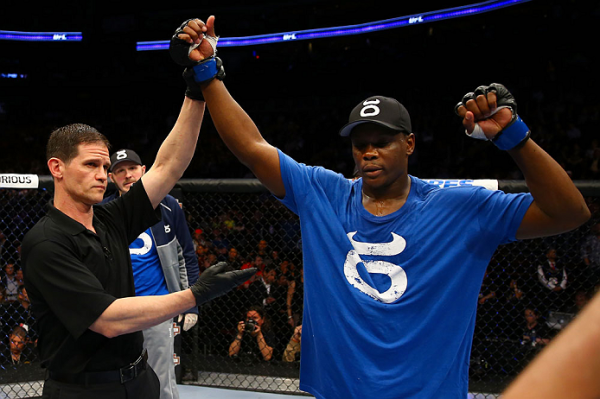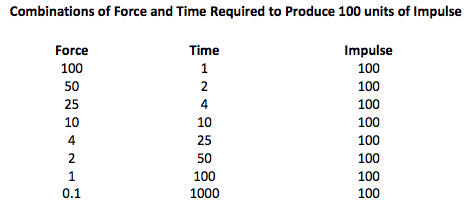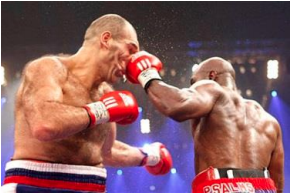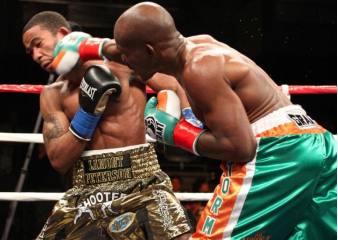
ProMMAnow.com (www.prommanow.com) is asking coaches, “Where does knockout power come from and how can a fighter develop it?”
Coach Eric Turner of Knoxville Martial Arts Academy and head coach of top-10 ranked UFC light heavyweight Ovince Saint Preux (who has some real power himself) weighs in with his thoughts on the subject. Open up the scientific calculator in your mind and strap in for this breakdown on what it takes to knock fools out.
[divider]
For KO power, I think you need a couple things, some physics and some psychology.
Everyone and their brother knows that Force = Mass x Acceleration. But is that all we’re really talking about, just force? I’d say we’re also talking about Impulse of Force. The impulse of force is commonly used to calculate forces in collisions (which is what we’re hoping for when we punch / kick someone).
Finally, we have to look at momentum change, we hope that all the force we’ve generated ends up in the other guy’s brain and not wasted on the air. So we need to look at the formula for
Momentum change. In the end we have:
Force = Mass * Acceleration
Impulse = Force * Time
Momentum Change = Mass * Δ Velocity
Luckily, we have the impulse-momentum change theorem, which states that:
Force * Time = Mass * Δ Velocity
(For those non-math nerds out there the weird little triangle (Δ) is a vector. A vector is a quantity having direction as well as magnitude, especially as determining the position of one point in space relative to another.)
So when we punch someone in an attempt to KO them we want the Force to be high and the time to be low. Think of it this way:

The greater the time over which the collision occurs, the smaller the force acting upon the object. Thus, to minimize the effect of the force on an object involved in a collision, the time must be increased. And to maximize the effect of the force on an object involved in a collision, the time must be decreased.
So now we’ve got some physics working for us! However, keep in mind that Newton’s third law of motion states: For every action there is an equal and opposite reaction. When we smack someone in the head, some of that force will go into them and some of that force will rebound away. It is in this instance that we want to make sure that the strike we are delivering is structurally sound, biomechanically. Depending on the strike thrown, this could incorporate a million different things. Suffice to say, that when you’re working on hitting something hard, you want to do everything you can to minimize the effects of Newton’s third law on your strike.
An example would be a Right Cross, for most orthodox strikers is one of their most powerful punches. However, in delivering a Right Cross, consider the effects of kinetic linkage. Kinetic linking is the combination of two principals: Acceleration of distal segments by a proximal segment. In simpler terms, the movement of one segment tends to also move adjacent segments. So a Right Cross starts from the ground and works up. The foot pivots to drive from the ground, the legs drive forward, the hips create torque by turning, the core and back muscles create additional torque/force, the shoulders assist by alternating a push on the right side and pull on the left side, the arm whips out and the hand finishes the strike.
Once completed the right side should have exhausted the complete supply of energy, however due to the nature of the way kinetic linking works, the opposite side of the body is over loaded with energy for a powerful strike.
Keep in mind, that each link along the chain should be studied to produce the most efficient and structurally stable position possible.
Third, you want to make sure that your timing is such that your opponent is moving into the strike instead of moving away. This is where feints, misdirection and combination strikes come into the picture. What we’re aiming at here is a collision.
There are two general types of collisions in physics: elastic and inelastic. An inelastic collisions occurs when two objects collide and do not bounce away from each other.
 The boxer on the left is demonstrating an inelastic collision. Note the severe facial deformation because his head has not begun to move away from the collision point.
The boxer on the left is demonstrating an inelastic collision. Note the severe facial deformation because his head has not begun to move away from the collision point.
Momentum is conserved, because the total momentum of both objects before and after the collision is the same. However, kinetic energy is not conserved. Some of the kinetic energy is converted into sound, heat, and deformation of the objects.
A strike, in general, is an inelastic collision. In the above example, if you calculated the momentum of the boxers before the collision and added it together, it would be equal to the momentum after the collision when the boxers are linked together. However, if you calculated the kinetic energy before and after the collision, you would find some of it had been converted to other forms of energy.
An elastic collision occurs when the two objects “bounce” apart when they collide. Two rubber balls are a good example as is rolling off a punch to avoid the power (as per the previously discussed impulse-momentum change theorem).
 The boxer on the left is demonstrating an elastic collision. Note the roll of his head away from the strike.
The boxer on the left is demonstrating an elastic collision. Note the roll of his head away from the strike.
In an elastic collision, both momentum and kinetic energy are conserved. Almost no energy is lost to sound, heat, or deformation. The fist deforms, but then quickly bounces back to its former shape, and transfers almost all the kinetic energy to the face.
Finally, you need to have the courage to deliver a strike. Punches, in general, can only be landed in the space where your opponent can also punch you as well. This no-man’s land is often called the “pocket” and it’s the distance at which you can hit your partner and your partner can usually hit you.
Fear is a vital response to physical and emotional danger — if we didn’t feel it, we couldn’t protect ourselves from legitimate threats. So, it’s reasonable to have some fear of being in the pocket – where you can hit and the other person can hit you back. However, here’s an easy acrostic to help fighters overcome fear:
The F-E-A-R System
F = Focus instead of freaking out. Place the emphasis on a positive outcome and a strong internal focus of control.
E = Expose instead of escape. Learn to make friends with the pocket and realize it’s the place where glory lies. Similarly, the best introduction to the pocket isn’t sparring, but in drilling that works up to sparring slowly and methodically.
A = Approach instead of avoid. When presented with the option of entering or running from the pocket, make the choice to enter – but enter on your terms, not your opponent’s terms.
R = Rehearse a lot. Think of this as drilling. How many drills do you do that start with you manipulating the pocket to your own end? If you don’t do a lot then you’re doing yourself a disservice!
So there we have it – some physics, some psychology – mix them together and you should have yourself a KO! Train hard and God bless you guys and girls out there!

[…] Knockout Power: Where it comes from and how to develop it with Coach Eric Turner – The post demonstrates that knockout power can be developed with some tricks and Coach Eric Turner is a master in this regard. […]